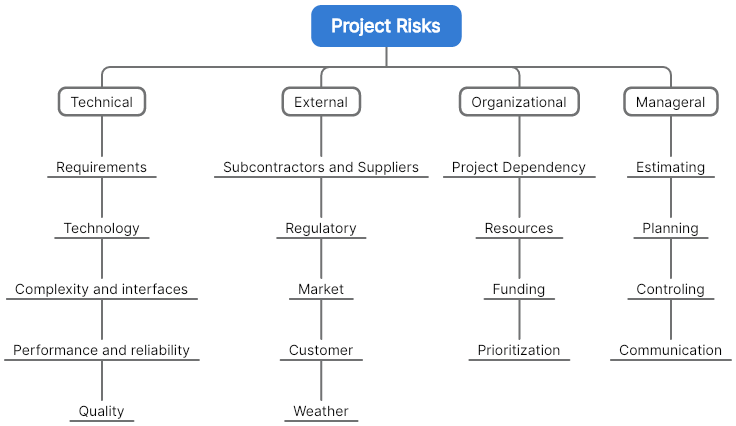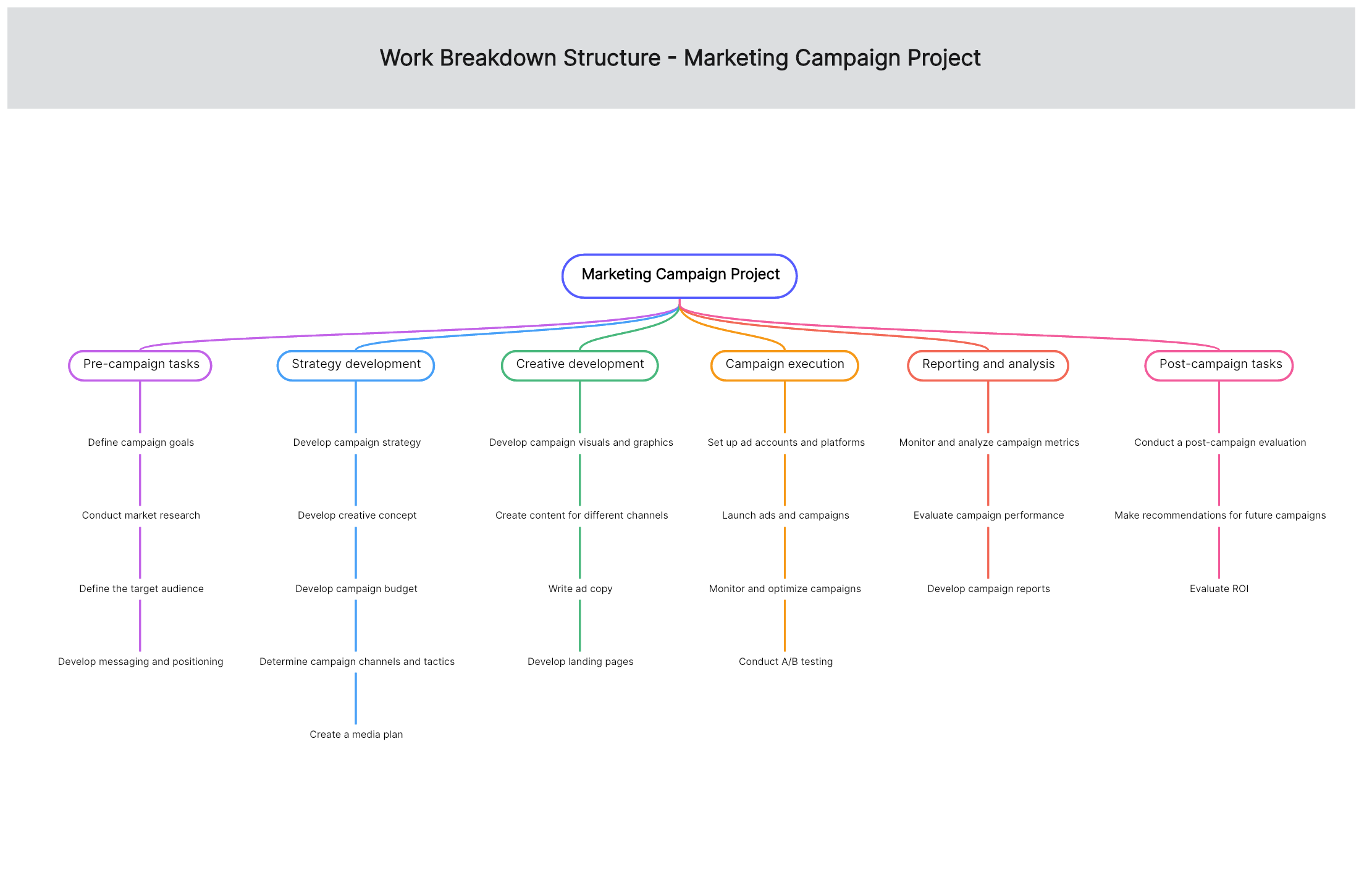Immerse yourself in the dynamic realm of project management, a field where risks are not just inevitable but also manageable with the right tools and strategies. This comprehensive guide is designed to take you on an enlightening journey through the concept of Risk Breakdown Structure (RBS), a crucial component in successful project management. We will delve into what RBS is, how it's created, and why it holds such significance in managing projects effectively and efficiently. As we navigate these waters, we'll also introduce you to a revolutionary tool that simplifies the process of creating an RBS, making it more accessible than ever before. Stay tuned for this exciting exploration into the world of risk management in projects.
Part 1. What Is RBS in Project Management?
The Risk Breakdown Structure (RBS) is a crucial tool in project management, serving as a hierarchical depiction of the potential risks that may arise during the course of a project. This structure breaks down and categorizes these risks according to their sources or nature, whether they are technical, organizational, external, or related to project management. By doing so, it provides a clear and structured overview that allows for more effective risk identification, assessment, and control. The RBS essentially acts as a roadmap for risk management, guiding teams in navigating through potential pitfalls and ensuring that every possible risk scenario has been considered and planned for. It's an invaluable asset in any project manager's toolkit for proactive and efficient risk management.
Part 2. How to Create a Risk Breakdown Structure in Project Management?
Creating a Risk Breakdown Structure (RBS) is a meticulous process that demands careful analysis, strategic planning, and a deep understanding of the project at hand.
Identify Potential Risks: It begins with the identification of potential risks that could impact various aspects of the project.
Categorize Risks: These risks are then categorized into relevant groups or levels based on their nature or source, such as technical risks, organizational risks, external risks, etc. This categorization aids in better understanding and managing these potential threats.
Create Hierarchical Structure: After categorizing the risks, arrange them in a hierarchical structure with the highest-level risks at the top and their sub-risks branching out below.
Review and Refine: Finally, review your Risk Breakdown Structure for completeness and accuracy. Make any necessary adjustments or additions to ensure it provides a comprehensive overview of all potential project risks.
Thus, creating an RBS is not just about listing out potential problems; it's about building a comprehensive risk management framework that enables proactive decision-making and effective project execution.
Part 3. How to Create RBS with Boardmix
Introducing Boardmix - your powerful partner in effortlessly crafting comprehensive Risk Breakdown Structures. Designed with an intuitive interface that is easy to navigate, Boardmix makes the process of creating an RBS not just simple, but also efficient. Our platform boasts an extensive library of templates tailored for various project needs, allowing you to choose the one that best fits your requirements. With Boardmix, the task of creating a detailed RBS becomes less daunting and more streamlined, enabling you to focus on what truly matters - effective risk management for successful project execution.
Key features include:
- User-friendly interface: Navigate easily through our platform.
- Extensive template library: Choose from numerous templates designed for various project needs.
- Real-time collaboration: Enables simultaneous work on the same RBS by multiple users, fostering effective teamwork and consistency across remote teams or large projects.
- Interactive elements: Allows the addition of interactive elements like notes, links, and attachments to each risk in your RBS, providing a richer context and detailed information.
- Scalability: Accommodate projects of all sizes, from small ones with few risks to large-scale ones with hundreds of potential risks, ensuring your RBS can be as simple or complex as required.
Here's your step-by-step guide to creating an RBS with Boardmix:
Step 1: Sign up or log in to Boardmix.
Step 2: Select an appropriate template from our library or start from scratch.
Step 3: Identify potential risks and input them into the chosen template.
Step 4: Categorize these risks based on their nature or source.
Step 5: Review and finalize your Risk Breakdown Structure.
Part 4. Why Is Breakdown Structure Important in Project Management?
It's important to understand that an RBS is not just a tool, but a strategic asset in project management. It serves as a comprehensive guide that illuminates potential risks and provides actionable insights for risk mitigation.
- Clear Visibility of Potential Risks: An RBS offers a clear, structured view of all potential risks associated with a project, making it easier to identify and understand these threats.
- Improved Risk Assessment Accuracy: By categorizing risks based on their nature or source, an RBS enhances the accuracy of risk assessment, enabling more precise planning and decision-making.
- Enhanced Communication: An RBS serves as a common language for discussing potential threats among team members, fostering better understanding and collaboration within the team.
- Effective Risk Mitigation Strategies: With its detailed overview of potential risks, an RBS aids in developing more targeted and effective risk mitigation strategies.
- Proactive Problem Solving: By identifying potential issues before they arise, an RBS allows teams to be proactive rather than reactive in addressing problems, leading to smoother project execution.
By leveraging these benefits, you can turn potential project risks from daunting challenges into manageable tasks with Boardmix's intuitive platform for creating comprehensive Risk Breakdown Structures.
FAQs about Risk Breakdown Structure in Project Management
1. What is a breakdown structure in project management?
A breakdown structure is a hierarchical decomposition of a project into manageable parts or phases for better control and organization. This strategic division allows for better control and organization, enabling project managers to effectively oversee each component without getting overwhelmed by the entirety of the project.
2. How does WBS help risk management?
The Work Breakdown Structure (WBS) is a powerful project management tool that aids in identifying potential risks at each phase of the project. By providing a detailed, hierarchical view of tasks, it enables proactive risk management strategies, fostering efficient planning and execution while minimizing unforeseen issues.
3. What is the breakdown of the project structure?
The breakdown of the project structure involves strategically dividing the entire project into smaller, manageable parts or phases. This approach enhances control, promotes organization, and facilitates efficient management throughout the project lifecycle.
Conclusion
Understanding and implementing Risk Breakdown Structures (RBS) can significantly enhance your ability to manage projects effectively. By proactively identifying and addressing potential risks, you can ensure smoother project execution and mitigate unforeseen challenges. Experience this efficiency firsthand with Boardmix – your reliable partner in project management. With its intuitive interface and extensive template library, Boardmix simplifies the process of creating comprehensive RBS, making risk management not just manageable but also effortless! Embrace a smarter approach to project management with Boardmix.













